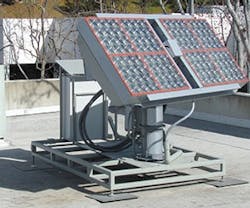No matter how much glass your facade uses or how low your partitions are, daylight can only penetrate so far into a building. However, a little-known technology could change that.
Hybrid lighting, also known as fiber optic daylighting, uses fiber optic cable to funnel natural light into spaces that can’t be reached with traditional daylighting technologies. This solution offers considerable energy savings but hasn’t yet developed a wide following because it’s relatively new and under constant development.
Could your facility become the first on the block to daylight core spaces?
How It Works
In a hybrid solar daylighting system, a rooftop tracking unit constantly readjusts itself to ensure maximum exposure to direct sunlight. An array of lenses captures the sun’s rays, strips away the infrared and UV parts of the spectrum, and pushes the visible light that’s left through bundles of plastic fiberoptic cable into luminaires that diffuse the light. These hybrid luminaires can also provide artificial light if not enough sun is available.
The system is simple to retrofit – the tracking unit mounts on a frame that sits on your roof, and the fiberoptic cables can be snaked into the building through a 4-inch penetration or an existing vent as small as 2 inches in diameter, explains Stan Rothwell, senior systems engineer for hybrid solar research and manufacturing firm Sunlight Direct.
“People have shown the most interest in illuminating the interiors of large-scale office buildings where windows normally wouldn’t be available,” Rothwell explains. “An accounting or IT department buried in the basement or the deep recesses of the building with no windows would be a good fit.”
When and Where to Use It
Buildings with a high number of clear, sunny days benefit most, such as those in California, Arizona, Colorado, and even Alaska, says Peter Guest, president and CEO of Sunlight Direct. The technology can be effective in most building types, but is typically selected for multi-story buildings where atriums and skylights aren’t viable options for cost or security reasons.
For example, the EnviroCenter, a Maryland office complex housing the Green Building Institute, installed hybrid lighting in 2007 to bring natural light into the front reception area, an interior office, and a mechanical room.
A post-installation review showed the spotlight in the mechanical room delivered 251 footcandles, while the ceiling fixtures in the interior office and reception area offered desktop readings of 34 and 41 footcandles respectively, near the IES recommendation of 50 (in most cases, hybrid luminaires would make up the shortfall). Your readings may be even higher if the fiber optic cable doesn’t have to go far, as shorter fiber runs won’t lose as much light during transmission.
A typical system produces roughly 250 lumens per watt using one collector, six to eight fiberoptic bundles (depending on the manufacturer), and a small amount of electricity to operate the tracker. Maintenance mostly consists of making sure the lenses on the tracker are clean, adds Eric Huffman, vice president of HUVCO Daylighting Solutions, which provided the EnviroCenter’s hybrid lighting system.
“Ironically, the power savings may not be the most significant place to save kilowatt-hours and pennies with hybrid lighting,” Rothwell says. “The fact that this technology produces a color-balanced, cool light without residual heat means that customers in warm climates will likely find a reduction in their air conditioning bills.”
Challenges and Considerations
Because the technology is still in development, costs are relatively high. A completed installation that can light 200-300 square feet of office space will cost roughly $10,000, Huffman says. Guest and Rothwell peg their system at a similar $40-50 per square foot of coverage, with hopes of driving the cost down to $18-20 per square foot through further research. This cost includes a hybrid luminaire, which accounts for about 5% of the total price.
Before signing on to hybrid lighting, consider whether it’s the best way to deliver daylight to your building’s core. Understanding your needs and managing your expectations will ensure that future hybrid solar projects are successful.
Janelle Penny [email protected] is associate editor of BUILDINGS.
About the Author
Janelle Penny
Editor-in-Chief at BUILDINGS
Janelle Penny has been with BUILDINGS since 2010. She is a two-time FOLIO: Eddie award winner who aims to deliver practical, actionable content for building owners and facilities professionals.

